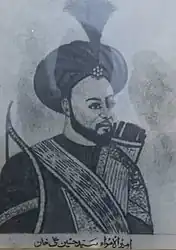The surname Al-Zaidi (Az-Zaidi) can denote one or both of the following:
- The descendants of Zayd ibn Ali (the grandson of Husayn ibn Ali, who was the grandson of the Islamic prophet Muhammad), who either stayed in Kufa, Iraq or returned to Hijaz (present-day Saudi Arabia. In the non-Arab Muslim majority countries, they often use the title Sayyid in their names.
- The use of the surname Al-Zaidi to designate association may be with the Zaidiyyah madhhab, whose adherents are found in Yemen. This is akin to the use of the surnames Al-Hanafi, Al-Maliki, Al-Shafi'i, etc.
People with the surname Zaidi are descendants of Zaid ibn Ali who was the son of Ali ibn al-Husayn Zayn al-'Abidin who himself was the great-grandson of Prophet Muhammad thus Zaidis are direct descendants of Prophet Muhammad and carry the title of Sayyid- an honorific title bestowed upon to the descendants of Muhammad. In Present times, Zaidis can be found in Iraq, Iran, Afghanistan and Pakistan.
The Wasitis/Zaidis in South Asia
The Zaidis of the Indian subcontinent use the proper noun "Wasiti" as a form of self-identification. Zayd ibn Ali is believed to have succumbed to injuries he sustain during a battle in Kufa, Iraq; many of his descendants either returned to al-Hijaz or remained in Iraq. Some of those who stayed in Iraq settled in Wasit. Some descendants from Wasit then moved to the Indian subcontinent. Most of the Zaidis migrated after the Mongol Siege of Baghdad in 1258. Most of them are settled in Iraq, Iran, Afghanistan, India and Pakistan.[1]
The largest group among those identifying themselves as Zaidi is Saadat-e-Bara. Saadat means descendant of Muhammad and Bara means twelve in Urdu. There are many interpretations of word bara and many spellings are current: Bara, Bahera, Barha (as spelled in Tuzuk-e-Jahangiri, Akbarnama and other Moghul sources) and Bahira meaning "bright" in Arabic language. One explanation of the word is as mentioned above; another is that there are twelve villages in Muzaffarnagar district and their residents were called Sadat Barha.
Aurangzeb wrote about the Syeds of Barha:[2]
"You should be extremely cautious in dealing with the Syeds of Barha...because a strong partner in government would soon seize the kingship for himself."
The Barha Sayyids in Muzaffarnagar rose as the de facto rulers of the Mughal empire, under their leaders Qutb-ul-Mulk and Ihtimam-ul-Mulk who deposed the Emperors Jahandar Shah, Farrukhsiyar, Rafi ud-Darajat and Shah Jahan II.[3]
 Qutb-ul-Mulk Hassan Ali Khan Barha
Qutb-ul-Mulk Hassan Ali Khan Barha Amir-ul-Umara Hussain Ali Khan Barha
Amir-ul-Umara Hussain Ali Khan Barha
These Sayyeds are descendants of Sayyid Abu'l Farah Al Hussaini Al Wasti who came to India from Wasit (Iraq) in the 11th century along with his four sons who settled in four villages of Punjab, Kundliwaal, Chhatbanur, Tihanpur and Jajner giving names to all four clans of Sadat Barha. Their numbers are highest in Karachi (Pakistan) and Muzaffarnagar (India). The Kundliwal clan mainly live in Mujhera, Hashimpur, and Sikrehra Khola. The Chhatraudi clan mainly live in Sambalhera. Many of them migrated to Pakistan during the partition of India.
Notable people with the surname Al-Zaidi
- Muntadhar al-Zaidi (born 1979), Iraqi broadcast journalist who serves as a correspondent for Iraqi-owned, Egyptian-based Al-Baghdadia TV
Notable people with the surname Zaidi
- Art and literature
- Ali Jawad Zaidi, Urdu poet and writer of India
- [ [ Adnan Haider Zaidi]], Research Scientist in USA
- Ali Naqi Zaidi (Safi Lakhnavi), Urdu poet of India
- Annie Zaidi, India English-language writer
- Askari Mian Zaidi (Askari Mian Irani), Pakistani artist, professor at National College of Arts
- Mohsin Zaidi, Indian Urdu poet
- Mustafa Zaidi, Urdu poet of Pakistan
- Nusrat Zaidi, Pakistani Urdu poet
- Sajida Zaidi, Indian educationist, Urdu writer and poet
- Ustad Sibte Jaafar Zaidi, poet, professor and head of various institutions in Pakistan
- Zahida Zaidi, Indian writer and critic
- Architecture
- Nayyar Ali Zaidi, Pakistani architect
- Government
- Shabbar Zaidi, 26th Chairman of Federal Board of Revenue
- Ijlal Haider Zaidi, Pakistani civil servant
- Ali Haider Zaidi, Pakistani Politician,Federal Minister for Maritime Affairs
- Bashir Hussain Zaidi, member of the first Lok Sabha and Vice Chancellor of AMU
- Nasim Zaidi, Chief Election Commissioner of India
- Sibte Hasan Zaidi, Indian toxicologist, head of the Industrial Toxicology Research Center
- Syed Nasim Ahmad Zaidi, Chief Election Commissioner of India
- Media
- Ashar Zaidi, Pakistani broadcast sports journalist
- Hasan Zaidi, Indian television actor
- Hussain Zaidi, Indian journalist and screenwriter
- Laila Zaidi, British actress
- Tanveer Zaidi, Indian actor, businessman and educationist
- Salman Zaidi, Indian television personality
- Shama Zaidi, Indian designer and filmmaker
- Zaigham Zaidi, Pakistani photographer
- Religion
- Ali Ausat Zaidi, Urdu soazkhawan of Pakistan
- Sibt-e-Jaafar Zaidi, Pakistani educator
- Sport
- Ashar Zaidi, Pakistani first-class cricketer
- Ashish Zaidi, Indian cricketer
- Mehdi Hassan Zaidi (Syed Modi), Indian badminton singles champion
- Zulqarnain Zaidi, former Pakistani cricketer
- Farhan Zaidi, President of Baseball Operations for the San Francisco Giants
See also
- Zaidiyah
- Sayyid
- Saadat-e-Bara
- Wasti, lists notable people with the surname Wasti
References
- ↑ Article by Sayyid 'Ali ibn 'Ali Al-Zaidi, التاريخ الصغير عن الشيعة اليمنيين (A short History of the Yemenite Shi‘ites, 2005)
- ↑ Sarkar (1912). Anecdotes of Aurangzib: Translated Into English with Notes and Historical Essays. M.C. Sarkar & Sons. p. 54.
- ↑ Sen, Sailendra (2013). A Textbook of Medieval Indian History. Primus Books. p. 193. ISBN 978-9-38060-734-4.